General Information / History
Since 1909, Texas A&M AgriLife Research Blackland Research and Extension Center (formerly Texas Agricultural Experiment Station) has been solving land and water solutions from its location on Texas’ Blackland prairie – this campus has been an essential partner in the prosperity and growth of Central Texas over the century by equipping farmers and stockmen with the knowledge they need to gain the most from their labors. The Center has remained on the forefront of research, meeting the needs of farmers, agribusinesses and conservationists and is renowned world-wide for the plant, soil and water computer simulation models its scientists have developed. Blackland Center researchers and the technologies they developed in Temple laboratories, have improved the lives of millions, in part by welcoming visiting scientists from around the world and sharing knowledge and encouraging mutual cooperation and peaceful uses of technology.
Acknowledgement: A special thanks to Charlie Tischler (USDA-ARS) for providing these documents. This article was taken from Texas Agricultural Process, Vol. 7, September-October 1961, No. 5
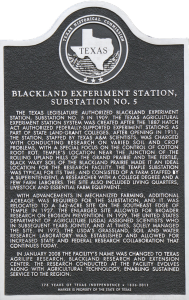
The Blackland Experiment Station, Substation No. 5, was authorized by the Texas Legislature in 1909 and was established at Temple to conduct research on varied soil and crop problems, with special attention to the control of cotton root rot.
The station was moved in 1927 to its present site of 542 acres on the southeast edge of Temple in the south-central part of the Blackland Prairies of Texas. Soil and water research was begun in 1931 in cooperation with the USDA Soil Conservation Service. Hybrid corn breeding became an important function in 1927, and beef cattle grazing and feeding research in 1937.
Increasing attention has been given to evaluating weather in relation to crop performance and conservation. Mechanization for all major crops, especially cotton, has been a research activity on the Blackland Station during the past 10 years. Field scale application of improved farming practices has provided the final testing of detailed research results and has served to demonstrate new information and methods to farmers and to other groups or agencies.
Most of the research is conducted in cooperation with the Soil and Water Conservation Division of the Agricultural Research Service, USDA, and with other substations and departments of the A&M College of Texas.
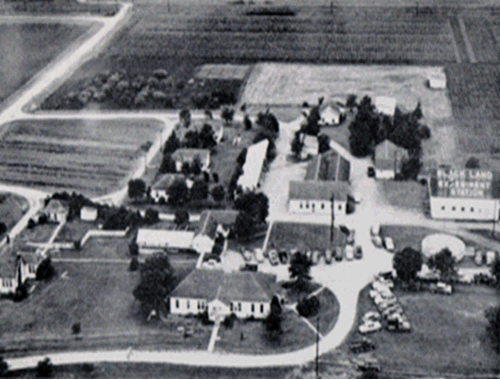
Weather records collected on this station for almost a half century provide many clues to farming progress. Research is directed toward lessening weather hazards and taking advantage of desirable weather characteristics. Early-maturing, spring-pIanted crops are benefited by dependable moisture in May. Severe summer drouth must be avoided or tolerated by any crop.
Summer rainfall increases cotton root rot. Inconsistent rainfall in the fall requires feed reserves for wintering livestock. Johnsongrass and weeds are controlled by proper timing of operations in relation to weather. The use of water by winter cover crops creates hazards for succeeding warm-season crops to be planted in the spring. Control of weeds and crop regrowth is essential for maximum storage of subsoil moisture.
Erosion control usually is adequate only when land is protected during May storms. Soil shrinkage and cracking because of drying is a primary factor in the control of runoff.
Blacklands soil puddles or packs easily when wet, and becomes difficult to work.
Phosphorus and nitrogen are the primary fertilizer needs in the Blacklands. Total phosphorus content of Blackland soils is medium, but the rate of availability often is inadequate for maximum crop production. Banded applications of 30 to 60 pounds of phosphoric acid per acre, as superphosphate, have increased yields in many tests, especially in combination with about 30 pounds of nitrogen. The need for nitrogen is closely related to moisture and temperature and to the previous crop.
Natural soil structure varies with original soil characteristics and with management. Shrinkage, swelling, cracking and stickiness are outstanding in the structure of Blacklands soils.
A variety of old methods of characterizing soil structure have been tested or modified and new methods are being developed with emphasis on the importance of moisture content and volume changes.
Research since 1931 has provided factual results which have served for many principles and practices in soil and water conservation. Present studies are conducted on terraces, small plots and field scale plots to evaluate cropping systems, crop residues and improved control practices, as well as to determine erosion tolerances for different soils.
Soil and water losses are held to a minimum by grass alone or with sweetclover. Small grains alone or with sweetclover are outstanding for the protection of sloping land during April and May when the most serious losses occur on cultivated land. Grain sorghum offers more promise for erosion control on sloping land than corn or cotton, especially when residues are managed on the surface. Soil cracks have proved effective in preventing runoff during any season.
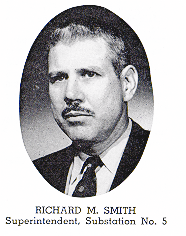
Soil moisture loss by evaporation is probably greater than is generally realized. The relatively high year-around temperatures (average 67 F.) and wind movement (4,511 miles per month) provide good drying conditions all year. Open pan evaporation has averaged 58.4 inches annually as compared with the annual rainfall of 34.4 inches. Shrinkage cracks expose considerable “hidden soil surface.” Cracks 3 to 4 inches wide at the top and 24 to 40 inches deep are not unusual during prolonged dry periods. Recent field measurements have shown from 2.9 to 4.6 times more surface area of soil exposed on the walls of the shrinkage crack than surface soil in an area of one square yard. Field and laboratory measurements have shown that the evaporation rate in shrinkage cracks is 50 to 60 percent of that from surface soil. It is estimated that evaporation from shrinkage cracks would be 1.5 to 2.0 times greater than from the surface soil.
Parallel-type terraces in the Blacklands mean fewer point rows, reduced erosion between terraces and less concentration of water at outlets. More grassed waterways, shorter terrace lengths and more smoothing of the land surface are requirements which sometimes may be costly. Improved terraces, diversions and outlets are being tested under experimental field conditions.
Two types of cotton are planted in the Blacklands area, the open boll type and the storm proof type. Much cotton in this area is the storm proof type which can be harvested with a mechanical stripper.
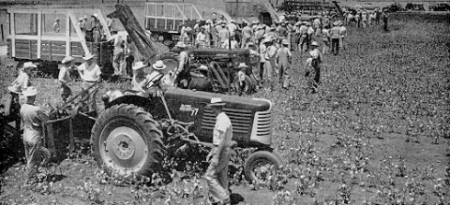
Mechanical harvest demonstration at the annual cotton field day.
Several factors must be considered in deciding when to plant cotton. A good rule is to plant anytime after April 10 when the average soil temperature at planting depth is close to 70 F.
For stripper harvesting and highest yields, spacing plants 2 to 3 inches apart in rows 40 inches apart is recommended.
A combination of nitrogen and phosphorus has increased cotton yields, especially following grain sorghum. Potash alone or in combinations with nitrogen and phosphorus does not result in additional increase. Recommended rates are 15 to 30 pounds of nitrogen (N) and approximately 30 pounds of phosphorus per acre. In rotations where cotton follows oats and clover fertilized with phosphate, additional fertilizer has not been needed.
Cultivation with a rotary hoe is helpful in controlling weeds if rain comes before cotton is up. It controls seedling weeds and breaks surface crusts. After cotton is established, weeds are controlled with a cultivator or by oiling with special shoe attachments. Hoeing or spot-oiling controls weeds later in the season.
Research is in progress to develop improved and more economical chemical and mechanical controls of Johnsongrass and weeds.
Proper drying of cotton leaves with desiccants, such as pentachlorophenol and arsenic acid, has proved dependable for stripper harvesting. Results from true defoliants have not been consistent. Tests show desiccants should not be applied before 75 percent of the bolls are open, and stripping should not be attempted when the leaves are moist. Stripper harvesting saves farmers $15 to $25 per bale over hand harvesting. Research also is being directed toward more efficient chemical defoliation.
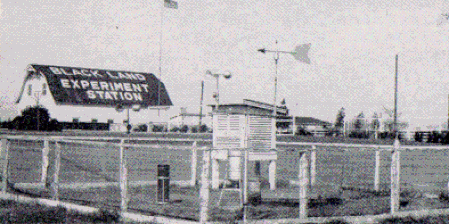
Weather recording devices used for the Blackland Station.
During most years, early-season insect control is necessary to produce high yields of cotton. Late-season treatments are based on intensity of infestation. Insect control is done according to recommendations by entomologists of the A&M College of Texas and the USDA.
Cotton root rot, caused by the soil fungus, Phymatotrichum omnivorum, is one of the most serious diseases of cotton in Texas. Although losses from this plant disease are confined largely to the Blacklands, it causes serious damage in the Lower Rio Grande Valley and El Paso region. Nearly all tap-rooted plants are subject to attack. Most types of orchard trees, vegetables, legumes such as sweetclover and alfalfa, and trees and shrubs used for landscaping also are susceptible. Because of its manner of attack, root rot is exceedingly difficult to control.
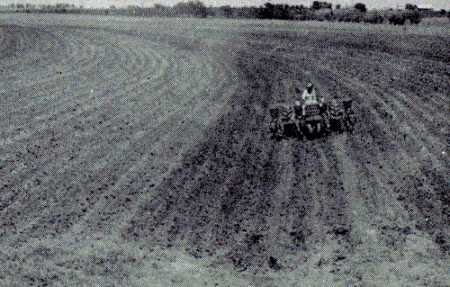
Planting operations on parallel terraces.
Agronomic practices which help avoid or reduce root rot are: early maturity, crop rotation, building-up of soil organic matter, early land preparation for soil drying and the proper use of fertilizers and soil fungicides. However, none has given adequate control. A more fundamental type of study is in progress, aimed at understanding the relationship among the root rot fungus, soil microbes and soil organic matter, and more effective control of the disease.
Control of damping-off diseases of seedling cotton is important in yield and mechanical harvest. Tests with a large number of commercial fungicides show seed or within-furrow treatment helps assure dense stands of vigorous plants.
Corn breeding research is aimed at developing inbred lines which will perform well in hybrid combinations in Central Texas. The testing program includes dent corn hybrids, single crosses and preliminary tests. Personnel from this station also supervise various types of corn performance tests at Holland, Plano and McGregor.
Dent corn hybrids which have performed best over several years include Texas 28 and 30, which have yellow grain and Texas 17W, an early maturing hybrid with white grain.
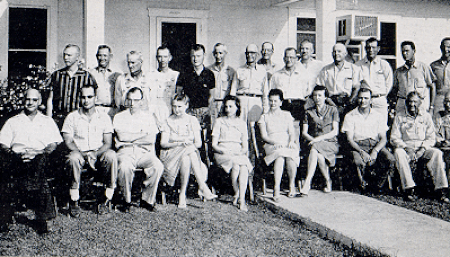
Above: Staff of Substation No. 5 in front of the office building. Front row, left to right – D. Over Thompson, Willie E. Kohutek, John E. Adams, Mrs. Hazel Hunn, Mrs. Erma L. Young, Mrs. Helen M. Gaby, Mrs. Zelda M. Williams, Ralph J. Hervey, Grover C. Camp and Alfred V. Redden. Back row – George D. Alston, Ralph C. Henderson, Clifford B. Baird, Morris J. Marburger, Donald O. Taylor, Elmer C. Mathis, Alva L. Cox, James W. Baird, Leo D. Dolan, Richard M. Smith, Elton D. Cook, Horace E. Stracener, Lewis E. Clark and Charles W. Rector
Newly released Texas 36A offers promise as a good early hybrid.
Popcorn and sweet corn tests also are grown. Sweet corn must have considerable resistance to earworms. Calumet appears outstanding.
Production experiments have been conducted to study the effect of certain cropping system-treatment combinations on the yields of corn. Definite responses to nitrogen, rotation, plant spacing, irrigation and heat have been established.
Large acreages of small grains are grown in the Blacklands. The testing on the Blackland Station seeks to determine the best varieties for grain, hay, grazing and use in conservation rotations for the area, and is part of the overall state and federal research on small grain improvement.
Yields are 1 to 1.5 tons of air-dry forage per acre during dry years, but are more in wet years.
Yield increases have been obtained from the application of fertilizers to oats, especially following grain sorghum. The most economical rate has been about 30 pounds each of nitrogen (N) and phosphorus per acre.
Grain sorghum breeding, recently begun on the Blackland Station, is aimed primarily at developing head-smut-resistant lines and hybrids and also hybrids which are shorter and will resist lodging. Some genetic and physiological studies are to be initiated.
Over the past 4 years, RS-610 has had outstanding yields here, as in other areas, but this hybrid is very susceptible to sorghum head smut. A group of experimental hybrids resistant to head smut, and 8 to 12 inches shorter than the presently grown hybrids, are being tested here and in other locations over Texas.
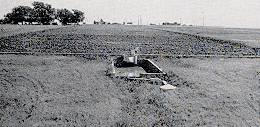
A controlled runoff plot of 1.5 acres on the Blackland Station showing the silt loss measuring devices.
Grain sorghum management studies include fertilization, date and rate of planting, row spacings, weed control, crop rotations and irrigation. Maximum yields and conservation are obtained from March plantings. Where weeds are controlled, higher yields have been obtained with 20 or 30-inch row spacings than with 10 or 40-inch rows. Combinations of nitrogen and phosphorus fertilizer have given good yield responses, especially where grain sorghum is grown repeatedly on the same land. Highest yields have been obtained with irrigation and following phosphated sweetclover. Shredding and prompt plowing to kill regrowth are necessary to assure high yields from crops grown following sorghum.
Hubam and bienniaI sweetclovers are planted with small grains for forage, seed or soil improvement, and to determine the effects of sweetclover on oat grain and forage yields and more about the root systems of the annual and biennial types of legumes. In cropping systems and in field grazing studies, the effects of sweetclovers and other legumes also are being evaluated in relation to soils, moisture, fertilization and the performance of following crops.
Silage varieties best adapted to this area include Honey, Sargo, Silo King, Tracy, Wiley and Sumac, producing 5 to 6 tons per acre, and NK320, Texas 9917, NK x 3058, Lindsey H5F, Texas 9910 and Beefbuilder, producing 7 to 8 tons, the best hybrids.
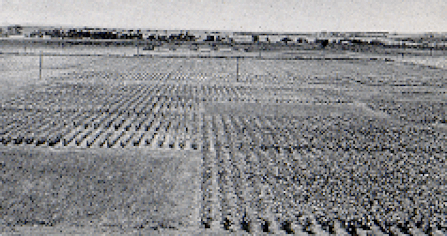
Grain sorgham fertilizer-irrigation-rotation test.
Sudangrass is an important summer forage plant for the Blackland area. It produces relatively high yields of forage of good quality for grazing or hay. Varieties which have produced the most forage in clipping experiments are Tift, Piper, Sweet and Common, and the hybrids are Sudax, Grazer, Texas 9901, 9902 and 9907.
The use of warm-season grasses is seriously limited because of the difficulty of their satisfactory establishment in competition with volunteer Johnsongrass, sourgrass and weeds. Some of the more promising grasses are K. R. bluestem, side-oats grama, Coastal and Common Bermudagrass and Johnsongrass.
Research on crop and production improvement considers the detailed relations of plant roots to soil and climatic factors. Root systems determined by digging up various plants under natural growing conditions have proved to be deeper than 5 or 6 feet.
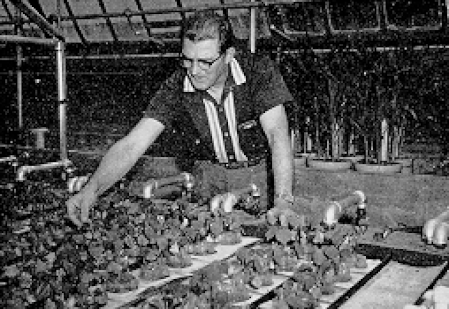
Cotton root-rot studies at the Blackland Station were conducted year-round in an air-conditioned greenhouse by means of a large constant soil-temperature apparatus.
Stocker calves of Good or Choice quality are purchased annually for grazing and feeding experiments. Improved grazing crops and practices are introduced and tested, and combinations of homegrown rations and management variables are compared in the feedlot.
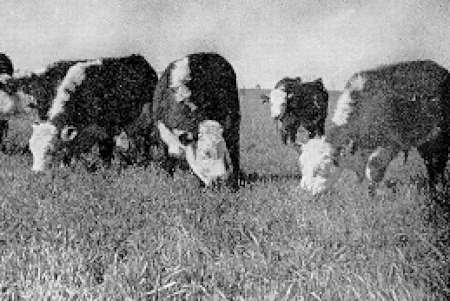
Beef steers grazing a forage mixture of small grain sweetclover.
Crop rotation studies have been conducted on the Blackland Station for many years. No single rotation superior in all respects, but results have been consistently favorable where warm-season row crops have been rotated with cool-season crops of small grain and for sweetclover.
New or improved materials and farming methods are tested in experimental fields. Soil conservation evaluations involve measured crops yields, chemical and physical determinations and estimates of erosion.
